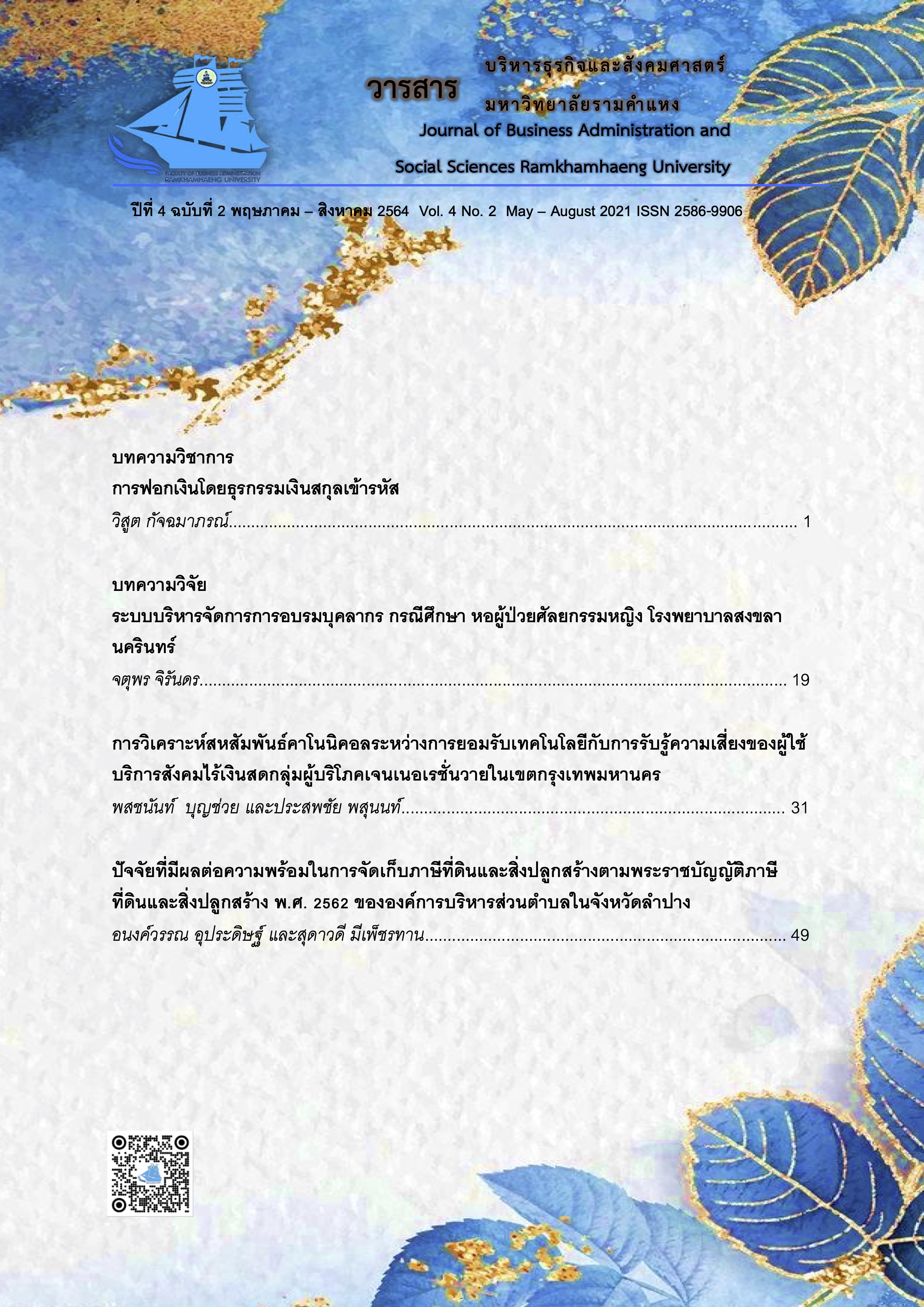The Canonical Correlation Analysis Between Technology Adoption and Perceived Risk of Cashless Society Users of Generation Y Consumers in Bangkok Metropolis
Main Article Content
Abstract
In this research investigation, the researchers examine technology adoption, the perceived risk, and the correlation between technology adoption and the perceived risk of cashless society users of generation Y consumers. Data were collected using a questionnaire. The technique of purposive sampling was employed to select only those who used the services of a cashless society. The statistics used in data analysis were frequency, percentage, mean, and standard deviation. The technique of canonical correlation coefficient was also employed. Findings showed that technology adoption and perceived risk were at a high level overall and in each aspect. The canonical correlation analysis found that technology adoption correlated with the perceived risk at the statistically significant level of .01 in one form only with R of 0.767 and R2 of 0.589. Technology adoption could be explanatory of the perceived risk at a moderate level (58.95 percent).
Article Details
เนื้อหาและข้อมูลในบทความที่ลงตีพิมพ์ในวารสารบริหารธุรกิจและสังคมศาสตร์ มหาวิทยาลัยรามคำแหง ถือเป็นข้อคิดเห็นและความรับผิดชอบของผู้เขียนบทความโดยตรง ซึ่งกองบรรณาธิการไม่จำเป็นต้องเห็นด้วย หรือร่วมรับผิดชอบใดๆ
บทความ ข้อมูล เนื้อหา รูปภาพ ฯลฯ ที่ได้รับการตีพิมพ์ในวารสารบริหารธุรกิจและสังคมศาสตร์ มหาวิทยาลัยรามคำแหง ถือเป็นลิขสิทธิ์ของวารสารบริหารธุรกิจและสังคมศาสตร์ มหาวิทยาลัยรามคำแหง หากบุคคลหรือหน่วยงานใดต้องการนำบทความทั้งหมดหรือส่วนหนึ่งส่วนใดไปเผยแพร่ต่อ หรือเพื่อกระทำการใดๆ จะต้องได้รับอนุญาตเป็นลายลักษณ์อักษรจากวารสารบริหารธุรกิจและสังคมศาสตร์ มหาวิทยาลัยรามคำแหง ก่อนเท่านั้น
References
กรณษา แสนละเอียด, พรีภาว์ ทวีสุข, และศรีไพร ศักดิ์รุ่งพงศากุล. (2560). การยอมรับเทคโนโลยีที่มีอิทธิพลต่อแนวโน้มความตั้งใจในการใช้บริการซื้อสินค้าผ่านช่องทางออนไลน์ของกลุ่มเบบี้บูมเมอร์ในกรุงเทพมหานคร. วารสารปัญญาภิวัฒน์, 9(3), 3-15.
กระทรวงดิจิทัลเพื่อเศรษฐกิจและสังคม. (2564). ETDA เปิดพฤติกรรมผู้ใช้อินเทอร์เน็ตปี 63 คนไทยใช้เน็ตเพิ่ม 11 ชั่วโมง 25 นาทีต่อวัน. จากhttps://mgronline.com/cyberbiz/detail/9640000034830
จริภา รุ่งเรืองศักดิ์. (2557). การศึกษาการยอมรับเทคโนโลยีและการรับรู้ความเสี่ยงที่ส่งผลต่อความไว้วางใจในการใช้บริการระบุตำแหน่ง ของผู้ใช้บริการในเขตกรุงเทพมหานคร. วิทยานิพนธ์บริหารธุรกิจมหาบัณฑิต, มหาวิทยาลัยกรุงเทพ.
ชลิตพันธ์ บุญมีสุวรรณ. (2561). สังคมไร้เงินสด (Cashless Society). วารสารธุรกิจปริทัศน์, 10(2), 235-248.
ถวิล ธาราโภชน์. (2526). จิตวิทยาสังคม (พิมพ์ครั้งที่ 3). กรุงเทพฯ: โอเดียนสโตร์.
นนทกร เทิดทูลทวีเดช. (2559). Cashless Society: เตรียมพร้อมเข้าสู่สังคมไร้เงินสดอย่างเต็มรูปแบบ. จาก https://www.scbeic.com/th/detail/.
นันท์ธิดา ทองดี. (2561). อิทธิพลภาพลักษณ์องค์กร การยอมรับเทคโนโลยี และการรับรู้ความเสี่ยงที่มีอิทธิพลต่อการตัดสินใจเลือกใช้กระเป๋าเงินอิเล็กทรอนิกส์ของผู้ใช้บริการในเขตกรุงเทพมหานคร. วิทยานิพนธ์บริหารธุรกิจมหาบัณฑิต, มหาวิทยาลัยเทคโนโลยีราชมงคลธัญบุรี.
นราทิพย์ ณ ระนอง. (2557). การเปิดรับข่าวสาร การรับรู้ความเสี่ยง และความตั้งใจใช้บริการธนาคารผ่าน
แอพพลิเคชั่นบนโทรศัพท์มือถือของผู้บริโภค.วิทยานิพนธ์บริหารธุรกิจมหาบัณฑิต, จุฬาลงกรณ์มหาวิทยาลัย.
ประสพชัย พสุนนท์. (2553). การวิจัยการตลาด (พิมพ์ครั้งที่ 1). กรุงเทพมหานคร: สำนักพิมพ์ ปริ้นท็อป.
ปาลี คล้ายเพชร. (2559). การเปรียบเทียบการยอมรับเทคโนโลยีโมบาย แบงก์กิง กรณีศึกษา MYMO กับ K-PLUS ในอำเภอหัวหิน จังหวัดประจวบคีรีขันธ์. ปริญญาบริหารธุรกิจมหาบัณฑิต มหาวิทยาลัยเทคโนโลยีราชมงคลรัตนโกสินทร์.
พสชนันท์ บุญช่วย และธีรวัฒน์ จันทึก. (2562). ความสัมพันธ์เชิงสาเหตุด้านความสนใจที่มีส่งผลต่อการตัดสินใจเลือกซื้อสินค้าออนไลน์ของเจนเนอเรชันวาย. วารสารหอการค้าไทย, 39(1), 22-36.
ฤทธิชัย วานิชย์หานนท์. (2559). Cashless Society กับประเทศไทย.จากhttp://www.sasinconsulting. com/wp-content/uploads/2016/09/Cashless-society.pdf.
วราพร วรเนตร และไกรฤกษ์ ปิ่นแก้ว. (2554). การรับรู้ความเสี่ยงความไว้วางใจและความตั้งใจซื้อประกันภัยผ่าน อินเทอร์เน็ต. การค้นคว้าอิสระปริญญามหาบัณฑิต, มหาวิทยาลัยกรุงเทพ.
สารานุกรมเสรี. (2561). สังคมไร้เงินสด, จาก The fletcher school tufts university p.9 : https://th.wikipedia.org/ wiki
สำนักงานธุรกรรมทางอิเล็กทรอนิกส์ (องค์มหาชน). (2561). ETDA เปิดพฤติกรรมผู้ใช้อินเทอร์เน็ตปี 61 คนไทยใช้เน็ตเพิ่ม 10 ชั่วโมง 5 นาทีต่อวัน. จาก https://www.etda.or.th/content/etda-reveals-thailand-internet-user-profile-2018.html.
สุทธิพงศ์ ตันติยานนท์ และ ธิดา บุญยเลขา. (2561). กรุงเทพมหานคร กำลังก้าวเข้าสู่ระบบดิจิทัล. จาก http://www.bltbangkok.com/CoverStory/
สุพัตรา วังเย็น. (2563). ปัจจัยที่มีผลต่อการยอมรับเทคโนโลยีที่ใช้สำหรับประมวลผลทางบัญชี กรณีศึกษา เจ้าหน้าที่สภาอุตสาหกรรมของประเทศไทย. สารนิพนธ์บัญชีมหาบัณฑิต, มหาวิทยาลัยธุรกิจบัณฑิต.
อณิยา ฉิมน้อย, ภูริวัฒน์ ตราเกียรติกุล, อัจจนา ล่ำซำ, จารีย์ ปิ่นทอง, และชนกานต์ ฤทธินนท์. (2561). เส้นทางสู่สังคม (กึ่ง) ไร้เงินสด. เข้าถึงได้จาก ธนาคารแห่งประเทศไทย และสถาบันวิจัยเศรษฐกิจ
ป๋วย อึ้งภากรณ์:.จากwww.bot.or.th/Thai/ResearchAndPublications/DocLib_/Article_28Aug 2018.
อรรถพงศ์ งานขยัน,และรสิตา สังข์บุญนาค. (2560). ความสัมพันธ์ระหว่างการยอมรับเทคโนโลยี การรับรู้ความเสี่ยง และแนวโน้มพฤติกรรมในการใช้บริการออนไลน์แอปพลิเคชัน ทรูมันนี วอลเล็ตของผู้บริโภคในเขตกรุงเทพมหานคร. วารสารวิชาการ สถาบันเทคโนโลยีสุวรรณภูมิ, 4(พิเศษ), 55-70.
Bauer, R.A. (1960). Consumer Behavior as Risk Taking : In Dynamic Marketing for a Changing World. Chicago: American Marketing Association.
Best, J. W. (1981). Research in Education. (3 rd ed.). Englewood cliffs, New Jersey.
Crawford, M. & Di Benedetto, A. (2014). New Products Management (11th ed.). New York, NY.
Cronbach, L. J. (1990). Essentials of Psychological Testing (5th ed.). New York : Harper Collins.
Davis, F (1989). A technology acceptance model for empirically testing new end-user information systems: theory and results. Unpublished Ph.D. dissertation,MIT Sloan School of Management, Cambridge, MA.
Fishbein, M., & Ajzen, I. (2010). Predicting and changing behavior : The reasoned action approach. New York: Psychology Press.
Forsythe, S. M. & Shi, B. (2003). Consumer patronage and risk perceptions in internet shopping. Journal of Business Research, 56, 867-875.
Green, I. F.R. (2005). The emancipatory potential of a new information system and its effect on technology acceptance. Ph.D. dissertation, Pretoria: University of Pretoria.
Hair, J. F., Black, W. C., Babin, B. J., & Anderson, R. E. (2010). Multivariate Data Analysis (7th ed.). Upper Saddle River, NJ: Prentice Hall.
Kim, E., Sung, Y., & Kang, H. (2014). Brand followers’ retweeting behavior on Twitter: How brand relationships influence brand electronic word-of-mouth. Computers in Human Behavior, 37, 18-25.
Kuo, H. M., Chen, C. W., & Hsu, C. H. (2012). A study of a B2C supporting interface desing system for the elderly. Human Facors and Ergonomics in Manufacturing & Service Industries, 22(6), 528-540.
Lignell, A. (2014). Older Consumers'Adoption for Online Shopping. Master’s Thesis, Lappeenranta University of Technology.
Luran, P. & Lin, H. (2005). Toward an understanding of the behavioral intenion to use mobile banking. Computers in Human Behavior, 21, 873-891.
Mannheim, K. (1970). The problem of generations. Psychoanalytic review, 57(3), 378-404.
McKechnie, S., Winklhofer, H., & Ennew,C. (2006). Applying the Technology Acceptance Model to Online Retailing of Financial Service: International Journal of Retail and Distribution Management, 34(4/5), 388-410.
Pakwan, S. (2561). อนาคตโลกกับ "สังคมไร้เงินสด" สู่การปรับตัวครั้งใหญ่ของเหล่าธนาคารพาณิชย์. จาก Next Business: https://nextempire.co/stories/next-business
Parveen, F., & Sulaiman, A., (2008). Technology complexity, personal innovativeness and intention to use wireless internet using mobile devices in Malaysia. International Review of Business Research Papers, 4(5), 1-10.
Piktialis, D. & Greenes, K. (2008). Bridging the Gaps: How to Transfer Knowledge in Today’s Multigenerational Workplace. The Conference Board. Research Report R-1428-08-RR.


